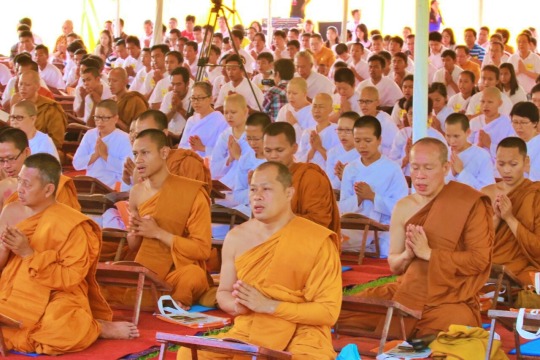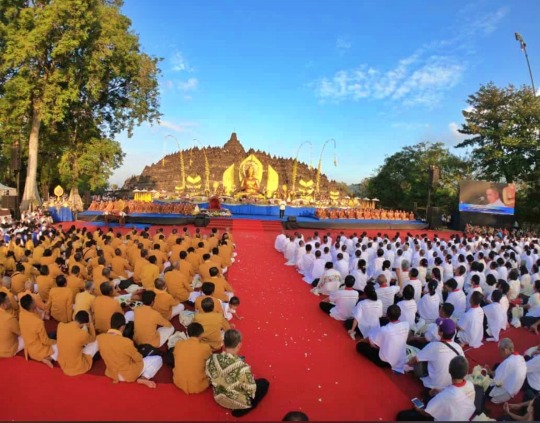#*tipitaka
Text
Do ignorant assholes realise that freedom of speech protects you from government prosecution for what you say not from people calling you an asshole for what you say?
#a 60 year old ex politics teacher was agreeing with a bunch of incels about how because you can’t be racist or homophobic or sexist anymore#that that means there is no freedom of speech#like bro you are so stupid it hurts#you CAN say all those things but you just gotta deal with the consequences of people calling you out on your bigotry#THATS STILL FREEDOM OF SPEECH#this same 60 year old teacher says he’s neutral to Israel and palestine as he “isnt educated enough to oppose either opinion”#like 1. it’s not a matter of opinion or it being complicated ITS GENOCIDE HOW ARE YOU GONNA SIT THERE AND BE LIKE IM ‘NEUTRAL’ TO GENOCIDE#2. you’ve had over 60 years on this earth to GET educated that’s not an excuse#little kids rn are in protests and can fully explain the entire history of Palestine and Israel#you’re a grown as hell man it’s not that hard to educate yourself#3. this same teacher said that it’s very complicated because it’s in their holy book#like okay so you’re telling me if it turns out the Quran or the tora or#or the Tripitaka had said that the uk or the USA was actually their holy land and birthright you’d be fine with getting massacred??#anyways fuck you alan ❤️#*tipitaka
10 notes
·
View notes
Text
Note this is only for academic research.
3 notes
·
View notes
Text

So.... the next few months are going to be tough!
#studyblr#langblr#100 days of productivity#teachblr#good god there's going to be one more class in April#The only thing keeping me alive is dropout tv and news of doctor who new eps tbh#oh that one in burmese is “introduction to tipitaka”
3 notes
·
View notes
Text
Tipitaka Chanting Diikuti Ribuan Umat Buddha Di Candi Borobudur Magelang
Tipitaka Chanting Diikuti Ribuan Umat Buddha Di Candi Borobudur Magelang
BNews–MAGELANG– Sekitar 1.200 umat Buddha mengikuti Indonesia Tripitaka atau Tipitaka Chanting (ITC) dan Asalha Puja di pelataran Candi Borobudur, di Kabupaten Magelang, Jawa Tengah, pada 8-10 Juli 2022.
Penasihat ITC 2022 Bante Subhapanno Mahathera di Magelang, Jumat, mengatakan ITC dan Asalha Puja dilaksanakan lagi di Candi Borobudur setelah dua tahun tidak dilakukan secara langsung di…

View On WordPress
#Berita Jateng#Berita Jogjakarta#Berita Nasional#Berita Viral#Borobudur News#Candi Borobudur#Magelang#Tipitaka Chanting
0 notes
Text
Do you think being trans is a trend?
Transgender people are known to have existed since ancient times. A wide range of societies had traditional third gender roles, or otherwise accepted trans people in some form. Historical understandings are inherently filtered through modern principles and were largely viewed through a medical lens until the late 1900s.
Trans history has also been filtered through gay history, with some historians erasing the trans identities of historical figures.
Ancient Egypt had third gender categories, including eunuchs. In the Tale of Two Brothers (from 3200 years ago), Bata removes his penis and tells his wife "I am a woman just like you"; one modern scholar called him temporarily (before his body is restored) "transgendered".
Prior to western contact, some Native American tribes had third-gender roles,[76] like the Diné (Navajo) nádleehi and the Zuni lhamana. European anthropologists usually referred to these people as berdaches, which Indigenous people have always considered an offensive slur. In 1990, some Indigenous North Americans, largely in academia, adopted the pan-Indian neologism two-spirit, as an attempt to organize inter-tribally.
In 1776, the Public Universal Friend reported being genderless, dressed androgynously, and asked followers gained while preaching throughout New England over the next four decades not to use their birth name or gendered pronouns
Prior to the 16th-century arrival of Spanish conquistadors, the Inca Empire and their Moche predecessors revered third-gender persons and organized their society around an Andean cosmovision that made room for masculine and feminine ambiguity based on "complementary dualism." Third-gender shamans as ritual practitioners were subject to violence as the Spanish suppressed pre-colonial worldviews.
In ancient Assyria, transgender cult prostitutes took part in public processions, singing, dancing, wearing costumes and sometimes women's clothes, carrying feminine symbols, and even at times performing the act of giving birth.
Eunuchs (who existed in China since 4000 years ago, were imperial servants by 3000 years ago, and were common as civil servants by the time of the Qin dynasty until a century ago) have sometimes been viewed as a third sex, or a transgender practice and Chinese histories have often expressed the relationship of a ruler to his officials in the terms of a male relationship to females.
Indian texts from as early as 3000 years ago document a third gender, which has been connected to the hijras who have formed a category of third-gender or trans-feminine people on the Indian subcontinent since ancient times.
The Buddhist Tipitaka, composed about 2100 years ago, documents four gender categories: female, male, pandaka, and ubhatobyanjanaka.
Drawings and figures from around 9000 to 3700 years ago, depicting androgynous and genderless humans in domestic, religious, and funerary settings, occur around the Mediterranean
Near what is today Prague, a burial from 4900 to 4500 years ago was found of a biologically male skeleton in a woman's outfit with feminine grave goods, which some archaeologists consider an early transgender burial.

#transgender#queer#lgbtq#lgbtq community#lesbian#lgbt pride#nonbinary#lgbtqia#nonbinary lesbian#gay girls#sapphic#trans pride#transfem#transexual#transmasc#trans#lgbt#lgbt art#lgbtqa#lgbtqplus#pride#lgbtlove#pride month#lgbtqiap
440 notes
·
View notes
Text
guys weve always existed were in the bible- i mean were in the illiad- i mean were in the vedas- i mean were in the spring and autumn annals- i mean were in the tipitaka- i mean
anyways this is about queer historiography. dont you think its weird how for example sinhalese and burnese fascism naturalize their worldview through the increasingly ancient representation of human nature in their base texts? or how hindutvas dispute claims to the vedas' time setting, and its implications for the natural role historical evidence of the hindu nation? or how eurofash are quick to point out the identically-reactionary lifestyles in antiquity?
do we help ourselves when we say that imperial divinity, which our fascist opponents will always revise to justify their mass violence, is the source of our queer permanence? do we even need mythology to forge our future of liberation together?
19 notes
·
View notes
Text

Teaching of all the Buddhas
The word 'Buddha' means the "Awakened One" or the
"Enlightened One," but in Buddhist teachings it generally refers to Lord Gautama Buddha who lived in India during the 6th and 5th centuries BC. Gautama Buddha is described as a Samma Sambuddha, one of three types of Buddhas according to Buddhism, the other two types being Pacceka or Private Buddha and Savaka or Disciple Buddha. Sammä Sambuddha means the 'Perfectly Enlightened One', sammã = perfectly; sam = by himself
without a teacher; buddha = Enlightened or Awakened
One, by realisation of the four Noble Truths. Following one's own full enlightenment, a Sammä Sambuddha, through compassion for other beings, is able to teach and guide others to attain enlightenment and escape from the cycle of birth and death (samsãra). Gautama Buddha was not in fact the first Sammã Sambuddha to appear in the world, as according to Buddhist literature, an innumerable number of Buddhas may have appeared in the past. In some schools of Buddhism, at least twenty eight Buddhas have been named including Gautama Buddha. It is also believed that another Buddha by the name of Maithriya will come into being at some point in the future.
Teaching of the Buddha encompasses all aspects of the Buddha's teaching that was delivered by Gautama Buddha during His ministry of 45 years. Initially, all of the Buddha's teachings were categorised into nine parts or angas based upon their form and style known as the nine-fold dispensation of the Buddha (navanga buddha sasana or navanga satthusasana). This was before the Pali Canon (tipitaka) came into existence. The nine-fold dispensation of the Buddha consisted of: Discourses (sutta) in prose, mixed prose and verse (geyya), elaboration of brief teachings (veyyakarana), verses (gatha), inspired utterances (udana) mostly in verse, sayings of the Buddha (itivuttaka) in mixed prose and verse, birth stories (jataka) of the Buddha's previous lives as a bodhisatta, extraordinary things or miracles (abbhutadhamma) and questions and answers (vedalla).
8 notes
·
View notes
Note
pilgrims thoughts on each other
Sun Wukong:
Pigsy: He views Pigsy essentially as he does in the original text, stupid, lazy, and cowardly. He enjoys teasing him to get a reaction out of him.
Sandy: A stick in the mud that thinks he's better than the rest of them because he does everything he's told- even though Wukong does it better. He's a sort of rival for savior's praise.
Ao Li: Temperamental little dragon, he views him as a child and should respect his elders, i.e Old Monkey.
Pigsy:
Sun Wukong: Arrogant jerk that's more trouble than he's worth. Pigsy doesn't like the fact that he's stuck with him but at the very least he's good at hitting things.
Sandy: He agrees that he's a bit stiff and a know-it all, but is glad that another former Celestial Being is around that agrees in his sentiments about Monkey. Also another one to help shoulder all the demons they have to deal with. Less trouble for him.
Ao Li: A young dragon, like with most others, views him as the kid of the group. Though him being a teen brings on the general teenage complaints.
Sandy:
Sun Wukong: Respects his strength but not much else concerning his reckless, arrogant, irresponsible and generally hard to get along with personality. But, because it was Tipitaka's decision to release him he doesn't question the decision too much.
Pigsy: Much the same as with Monkey but with no teasing, lazy and a coward.
Ao Li: Is sympathetic towards his punishment and sees him as a youth that needs help in tempering himself.
Ao Li:
Sun Wukong: Not a fan. To say the least. He views him as the reason his family's reputation took a downfall and as such doesn't like him but puts up with him being there so he can redeem himself in the eyes of his family.
Pigsy: Not much different from the rest, but likes him more than Monkey, he isn't afraid to call him out for being a lazy coward much like Monkey and Sandy are, but does it with more of teenage sarcasm.
Sandy: He likes him because he's sympathetic towards his plight so the two get along well and have a level of understanding between them.
#i think that's all of it#journey to the west chronicle#journey to the west#xi you ji#sun wukong#the monkey king#stone monkey#great sage#lmk pigsy#pigsy#zhu bajie#celestial swine#sandy#wuijing#ao lie lmk#ao lie monkie kid#jade dragon#dragon horse#answer#themissdnl
23 notes
·
View notes
Note
sorry I know you have a lota asks but. If the whole jttw crew come back after wukong starts stimming again. imagen wukong getting really exited about something and he starts shaking his hands or something and Tipitaka stares at he and goes "monkey stop that! it's improper I thought I tort you better then this". immedently all the excitement is gone. He puts his hands by his side, his shoulder hike up, his head and tail drop "Sorry Master". "That's better". imagen everyone watching this.
GOD....... MMMMMMM...
Oh I think Xiaotian would step in at that...
#the idea of qxt saying that he was doing nothing wrong he was jsut excited and tripitaka mentioning that it's improper behavior...#oh man#BUT AHEM YES GOOD GOOD STUFF ANON YES
52 notes
·
View notes
Video
youtube
Love Story (LMK Shadow peach Animatic)
Ok, major problem I have with pracitly every story I hear about a persons interpretation of the JTTW is that they never touch on the amount of torment Wukong went through before the journey? He was captured in a battle with his sworn brothers not doing anything as he was captured by the heavens and taken to get tortured as an attempt to kill him, then after that didn’t work he was boiled alive, and then after his eyes where changed to a different color (do you have any idea how painful that would have to be for his eyes to go from white to blood shot red!?) he was thrown under a mountain for 500 years with zero social interaction based on the original text and in case you didn’t know like humans’ monkeys are very social animals and no social attention for a week can lead to a multitube of metal effects. And before you say, “But he’s immortal he can’t feel it!” there is nothing in immortality that says that the immortal can’t feel any pain anymore. Also, you’re going to tell me the Tipitaka is completely innocent? This man that is a MONK and is supposed to see everyone to some capacity as a living being that deserves respect and kindness, keep in mind he follows this way of thinking for everyone BUT WUKONG. That is just mind boggling to me because he’s almost always correct when it comes to seeing threats and demons and such. Pigsy not once gets shouted at or even corrected with the amount of times that he ditches and lies but Wukong does one thing that Tipitaka doesn’t like and its straight to migraine city for WUkong. That is just absolute bullshit to me. Thank you for letting me rant but I swear people can be so blind to very clear abuse being they see it as ‘doing the right thing’ or ‘doing the only thing that works’ because they refuse to look at reasons why and instead go straight to the problem. I swear, this is why I can’t be left alone with my thoughts.
1 note
·
View note
Text
5 notes
·
View notes
Text
0 notes
Text
Mulai Hari ini, Indonesia Tipiṭaka Chanting (ITC) & Āsālha Mahāpūjā Digelar Di Candi Borobudur Magelang
Mulai Hari ini, Indonesia Tipiṭaka Chanting (ITC) & Āsālha Mahāpūjā Digelar Di Candi Borobudur Magelang
BNews–MAGELANG— Mulai hari ini 8 Juli 2022, agenda Tipitaka Chanting digelar oleh Umat Buddha di kawasan CandiMendut dan Borobudur. Kegiatan tersebut direncanakan akan berlangsung selama 3 hari sampai Minggu 10 Juli 2022.
Kegiatan itu adalah pembacaan kitab suci Tipitaka yang merupakan bagian kegiatan dari Pujabakti Agung Asadha. Dimana hal itu untuk melestarikan Dhamma ajaran Budha untuk…

View On WordPress
#Berita Jateng#Berita Jogjakarta#Berita Magelang#Berita Nasional#Berita Viral#Borobudur News#Budha#Candi Borobudur#Magelang#Tipitaka Chanting
0 notes
Text

การค้นพบศาสนาบูธ: การเปิดเผยธรรมชาติที่แท้จริงของบรรทัดที่ศักดิ์สิทธิ์ (การค้นพบศาสนาบูธ: การเปิดเผยธรรมชาติที่แท้จริงของบรรทัดที่ศักดิ์สิทธิ์)
บูชาเป็นหนึ่งในศาสนาหลักของโลก ให้ความเห็นที่สําคัญในความเป็นอยู่ของมนุษย์ผ่านข้อความศักดิ์สิทธิ์ของมัน "ค้นพบข้อความศักดิ์สิทธิ์: บูชา" เป็นภาพยนตร์ YouTube ที่ดึงดูดความสนใจ ให้ผู้ชมเห็นบทเรียนและข้อความที่ซับซ้อนมากมายของบูชา ตอนนี้เราจะตรวจสอบจุดสําคัญของคําพูดที่สอดคล้องกันนี้เปิดเผย:
สามอัญมณี: ฐานพื้นฐานของความเชื่อบูดิสต์
ความคิดของสามอัญมณี - บูธดา ดาร์ม่า และซังฮา - เป็นพื้นฐานของศาสนาบูชา สิ่งเหล่านี้หมายถึงชุมชนของผู้ปฏิบัติการ ผู้สอน และเส้นทางในการปฏิบัติตามลําดับนั้น เหล่านี้สามคอลัมน์ให้แรงบันดาลใจและคําแนะนําสําหรับบูดิสต์ในเส้นทางจิตวิญญาณของพวกเขา และพวกเขาก็เป็นสถานที่บริสุทธิ์สําหรับพวกเขา
การกระจายตัวในพื้นที่และศุลกากร
มีสาม���รงเรียนหลักของศาสนาบูชา: Theravada, Vajrayana, และ Mahayana ทุกประเพณีมีธรรมดาที่แตกต่างกันและเน้นทางภูมิศาสตร์ที่เฉพาะเจาะจง
การแพร่กระจายของศาสนาบูธในพื้นที่ต่างๆและช่องว่างในการสื่อสารที่เกิดจากมันส่งผลกระทบต่อความสําคัญของข้อความที่เฉพาะเจาะจงในแต่ละโรงเรียน
การเดินทางของซิดฮาร์ต้ากั๊อตมา
ฟิล์มนี้บอกเรื่องราวของบูดาแห่งประวัติศาสตร์ ซิดธาห์กั๊อตาม่า ผู้ที่ทิ้งการเลี้ยงลูกชายของเขาเพื่อหาความสว่างและความจริง การถ่ายทอดบทเรียนของซิดธาห์เป็นไปได้โดยการส่องสว่างของเขาภายใต้ต้นไม้บอดี้ซึ่งเป็นจุดสุดยอดของการรับรู้ที่ลึกซึ้งเกี่ยวกับความสําคัญของความเป็นอยู่
The Tipitaka: สถาปัตยกรรมโบสถ์
"สามถัง" หรือ Vinaya Pitaka, Sutta Pitaka และ Abhidhamma Pitaka สร้างขึ้นจาก Tipitaka โมงเหล่านี้รวมถึงคําสอนโบสถ์ที่ซับซ้อน กฎระเบียบของศาสตราจารย์และบทเรียนเกี่ยวกับจิตวิทยาและปรัชญาของบูดิสต์
คําสอนของเทนทริกและแมฮาห์นา
โรงเรียนเทอเรวาดาส่วนใหญ่ใช้คานอนพาลี ในขณะที่ประเพณีเวจราเอานาและมาฮายานายังใช้คัมภีร์อื่น ๆ การสอนของเทนทริกให้เทคนิคของความลึกลับ เพื่อบรรลุการเปลี่ยนแปลงทางจิตวิญญาณ ในขณะที่การสอนของมาฮายาน่า มุ่งเน้นไปที่ความเห็นอกเห็นใจและความสมบูรณ์แบบของบอดhisattva
ชีวิตและคําสั่งในโบสถ์
- ผ่านการศึกษาและการสอน มนกและสุภาพบุรุษเป็นสิ่งสําคัญในการรักษาและการแพร่กระจายบทเรียนของโบสถ์ กฎเกณฑ์ที่ควบคุมชีวิตของโบสถ์ และศัตรูต้องปฏิบัติตามกฎการปฏิบัติที่เข้มงวดซึ่งมีวัตถุประสงค์เพื่อเสริมสร้างความจริยธรรมและความกฏหมายทางจิตวิญญาณ
การแสดงความขอบคุณและสนับสนุนต่อซานก้า
- นักปฏิบัติคนเลวให้อาหารที่อยู่อาศัย และสิ่งสําคัญอื่น ๆ สําหรับกลุ่มโบสถ์ ซานจาซึ่งประกอบด้วยโบสถ์ มีความเคารพสําหรับบทบาทในการปกป้องและการส่งมอบบทเรียนของบอดดาให้รุ่นหน้า
การเก็บรักษาและแบ่งปัน พระคัมภีร์บริสุทธิ์
- ภาพยนตร์เรื่องนี้ให้ภาพรวมของข้อความโบสถ์แรก เช่น โลตัสซูทราและไดมอนต์ซูตรา หนังสือเล่มโบสถ์สามารถทําซ้ําได้ในแบบที่ถูกแพร่กระจายอย่างกว้างขวางและได้รับการปกป้องด้วยความช่วยเหลือของการปฏิวัติการพิมพ์
ประเพณีโบราณของโบสถ์โคปต์: มรดกที่อุดมไปด้วยและต้นกําเนิดของโบราธ
- พระมหากษัตริย์แห่งโบสถ์โคปต์ในอียิปต์ ในปี 55 ศ. นี่คือจุดเริ่มต้นของประวัติศาสตร์ของคริสตจักร
- ประเพณีของคัปต์ซึ่งมีอยู่อย่างต่อเนื่องมานานกว่า 2,000 ปี มีความรู้มากมายที่ถูกเก็บไว้ในพระคัมภีร์บริสุทธิ์, บรรยายโบราณและบรรยายของบรรดาบรรดาผู้ปกครองคริสตจักรครั้งแรก งานของเซนต์เบซิล, เซนต์เกรโกเรียและเซนท์ไซริลเป็นสิ่งสําคัญสําหรับงานบริสุทธิ์ของโบสถ์และช่วยสร้างการเคารพที่อุดมไปด้วยความรู้สึก
การพบปะที่เกี่ยวข้องกับการสัมผัสเสียงและวิสัยทัศน์
ศาสนา: ความสอดคล้องระหว่างความแตกต่าง
- คริสตจักรคาทอลิคซึ่งมีผู้ติดตามเกือบ 1.2 พันล้านคนทั่วโลก มุ่งเน้นไปที่ความซับซ้อนในหมู่สมาชิกที่หลากหลายของมัน
- การเคารพศาสนาคาทอลิคถูกจัดระเบียบตามวงจรบริสุทธิ์ที่ช่วยเพิ่มจิตวิญญาณของการเฉลิมฉลองในกลุ่มและประสบการณ์ทางศาสนาร่วมกันตลอดทั้งปีของคริสตจักร
- วิธีหลักที่ชาวคาทอลิคโต้ตอบกับพระคัมภีร์ไบเบิลคือ ในช่วงงานศพ เมื่อการอ่านและบทสนทนาช่วยให้สมาชิกในครมเข้าใจความหมายและการประยุกต์ใช้ของบรรทัดต่าง ๆ ของพระบิดา
การมีอิทธิพลจากศาสนาโพรสเตน: การปฏิเสธและการตีความใหม่
- ความพยายามของยุโรปที่จะเปลี่ยนบทเรียนและปฏิบัติการของคริสตจักรคาทอลิกโรมันก่อให้เกิดการปฏิเสธศรัทธา
- คนเช่น วิลเลียม ไทนดอลมีส่วนร่วมในการนําพระคัมภีร์เข้าสู่ภาษาทั่วไป ดังนั้นจึงขยายผู้ชมของพระคริสต์และทําลายอํานาจของศาสตราจารย์
- การฟื้นฟูภาษาอังกฤษได้ให้เกิดคริสตจักรของอังกฤษซึ่งเป็นตัวแทน หลังจากการแยกจากโบสถ์คริสตจักรคริสเตียนโรมัน อังกฤษได้สร้างตัวละครที่เป็นเอกลักษณ์ของตัวเองในช่วงหลายศตวรรษ
กระบวนการ: ยอมรับการมีส่วนร่วมในสังคมและการมีชีวิตชีวาทางวิญญาณ
การฟื้นฟูแห่งโบสถ์แห่งอังกฤษ ของพี่น้องเวสลีย์ได้ก่อให้เกิดศาสนาเมทโธดิสต์ ซึ่งให้ความสําคัญอย่างยิ่งกับกิจกรรมทางสังคม การศึกษาพระคัมภีร์และคณิตศาสตร์ทางจิตวิญญาณ
- มีผู้ติดตามมากกว่า 75 ล้านคน ในทั่วโลก นักวิจารณ์ Methodists ใส่ความสําคัญอย่างยิ่งกับนิรันดี้เป็นเครื่องมือในการแสดงออกทางจิตวิญญาณและการสอนทางศาสนา คุ้มค่าที่ยาวนานของเพลงเพลงเช่น "ความรักพระเจ้า, ความรักทั้งหมดที่ยอดเยี่ยม" ในการสื่อสารความรักและความอยู่รอดของพระเจ้าเป็นสิ่งที่อธิบายได้ดีที่สุดโดยหนังสือเพลงเพลงเพลงของโบสถ์เวสเลียน Methodist จากแอฟริกาใต้
ความคิดสุดท้าย: ยกเกียรติความหลากหลาย, ยืนยันความสามัคคี
ช่วงที่หลากหลายของศาสนาคริสเตียนแสดงให้เห็นถึงความเกี่ยวข้องที่ยาวนานและความสามารถในการปรับตัวกับสถานการณ์และวัฒนธรรมที่หลากหลาย แม้ว่าจะมีการแบ่งออกทางศาสนามากมาย แต่ความเชื่อในพระเยซูคริสต์เป็นผู้ช่วยก็เกินความแตกต่างทางทฤษฎี
การสร้างชุมชนโลกแห่งความศรัทธาในหมู่ชาวคริสเตียน
Discovering Sacred Texts: Buddhism" โดยพื้นฐานให้ผู้ชมความเข้าใจที่ดีกว่าของพระคัมภีร์แห่งโบสถ์, ธีม, และปรัชญา วิดีโอนี้เชิญผู้ชมเข้าสู่การเดินทางที่เปลี่ยนแปลงของการค้นพบตนเองและการตื่นเต้นทางวิญญาณผ่านการสืบสวนพระคัมภีร์โบราณและประเพณี
0 notes
Note
hello and happy new year! i wanted to ask about your resources for learning about buddhism. i enjoy your philosophical and spiritual thoughts and am hoping to find more ways to learn about or get into it, if you have any to share!
your local sangha and dharma leader!
bare essentials: buddhanet dot net!
personal rec: studybuddhism dot com! (tibetan focus, love alex berzin!)
library; WIP, buddhist canon: 84000!
library; theravada suttas (tipitaka): dhammatalks dot org!*
(i lack other centralized theravada (predominantly south- and southeast-asian) libraries! i scavenged!)
essential zen practice: thích nhất hạnh!
essential tibetan: fpmt dot org! (lama yeshe and lama zopa rinpoche are prolific gelug authors!)
(i only rec TNH and zen because theyre on-the-shelf so to speak, and i dont recall any centralized mahayana libraries ive used for my scavenging!)
online sangha: dharmawheel dot com for mahayana, dhammawheel dot com for theravada!
online sangha: theres a discord server somewhere out there if i can find it comprised a spectrum between laymen and experts! lmk if you want me to look!
when researching i rec starting from scholastic cohorts that instigate schisms! then tracing their old schools lineage!
i hope you see this and dont just follow my reblog blog! <3
*previous version listed accesstoinsight dot com, which a dear friend of mine (@unthinkingclunk) corrected as follows:
FYI accesstoinsight is largely "dead"-- it's not being updated anymore, you can see this link for details:
https://www.dhammatalks.org/suttas/ati.html
But in short you'll see many links to accesstoinsight all over but those pages now largely point out at the top of the page (for any specific sutta) that the current site is dhammatalks.org (which is the base site of the link I posted)
14 notes
·
View notes
Text

Understanding Hungry Spirits in Buddhist Philosophy
In Buddhist teachings, the concept of hungry spirits holds significance as part of the cycle of rebirth, influenced by one's kamma—intentional thoughts, speech, and actions. This article explores the role of hungry spirits, their characteristics, and their relevance in the Buddha's teachings.
Categories of Existence:
According to Buddhist doctrine, beings can exist as humans, animals, gods, angry spirits, hungry spirits, or purgatorial beings. Rebirth into these states is determined by the kamma one accumulates in their lifetime. Excessive greed and constant dissatisfaction, for instance, may lead to rebirth as a hungry spirit.
Nature of Hungry Spirits:
Hungry spirits, as described in the Tipitaka, are beings in a state of discontent and misery. A poignant example is found in the scripture (Ja.V,68) where a leper is referred to as 'a peta-like human,' emphasizing the wretchedness associated with this state of existence.
Relationship with Living Relatives:
Buddhist scriptures suggest that hungry spirits may be sensitive to the thoughts and feelings of their living relatives. While there is no indication that they can haunt or be conjured by humans, there is an implied connection between the living and the hungry spirits through the realm of consciousness.
Prohibition of Discussing Hungry Spirits:
The Buddha discouraged the discussion of hungry spirits (petakatha), deeming it unbecoming and unskillful speech. This prohibition may stem from a desire to focus on practices leading to enlightenment rather than dwelling on the distressing aspects of certain realms.
Implications for Practitioners:
Understanding the existence of hungry spirits serves as a reminder of the consequences of negative actions and the importance of cultivating wholesome thoughts and deeds. Practitioners are encouraged to follow the Noble Eightfold Path to break free from the cycle of rebirth and attain liberation (nibbana).
Conclusion:
Hungry spirits play a vital role in Buddhist cosmology, symbolizing the consequences of unwholesome actions and the potential for suffering in various realms of existence. The Buddha's teachings emphasize the importance of mindfulness, ethical conduct, and compassion to navigate the complexities of the karmic cycle and attain spiritual liberation.
7 notes
·
View notes